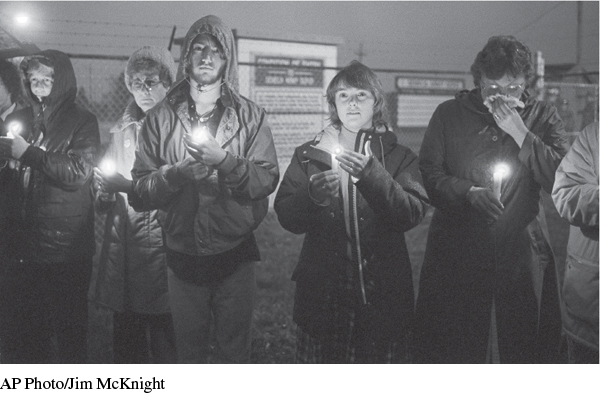The Nuclear Freeze Movement
Despite his tough talk and military buildup, Reagan was not immune to public pressure. Rising protests against nuclear weapons in the United States and Europe in the early 1980s revealed a public increasingly anxious about the possibility of nuclear confrontation with the Soviet Union. At the end of the Carter administration, the United States had promised NATO that it would station new missiles in England, Italy, West Germany, and Belgium. Coupled with his confrontational stance against the Soviet Union, Reagan’s decision to implement this policy sparked enormous protest. One such protest came in 1981 when peace activists set up camp at Greenham Common in England outside of one of the military bases prepared to house the arriving missiles, one of twenty such camps in England. The peace camp at Greenham Common, where protesters sang, danced, and performed skits to affirm women’s solidarity for peace, became the model for the Women’s Encampment for a Future of Peace and Justice at Seneca Falls, where Barbara Deming and other activists staged demonstrations. Thus, women came together not only to promote disarmament but also to empower themselves and create supportive communities dedicated to peace.

Explore
See Documents 28.2 and 28.3 to read about two nuclear freeze efforts.
These activities were part of a larger nuclear freeze movement that began in 1980. Its proponents called for a “mutual freeze on the testing, production, and deployment of nuclear weapons and of missiles and aircraft designed primarily to deliver nuclear weapons.” Grassroots activists also held town meetings throughout the United States to mobilize ordinary citizens to speak out against nuclear proliferation. In 1982 some 750,000 people rallied in New York City’s Central Park to support a nuclear freeze resolution presented at the United Nations. Despite opposition from the United States and its NATO allies, measures favoring the freeze easily passed in the UN General Assembly. In the 1982 elections, peace groups placed nonbinding, nuclear freeze referenda on local ballots, which passed with wide majorities. The nuclear freeze movement’s momentum carried over to Congress, where the House of Representatives narrowly rejected an “immediate freeze” by only two votes.
Demonstrations in the United States and in Europe influenced Reagan. According to a 1982 public opinion poll, 57 percent of Americans favored an immediate nuclear freeze. Reagan acknowledged that he was more inclined to reconsider deploying missiles abroad because European leaders felt pressure from protesters in their home countries. Ironically, the president credited Europeans’ sentiments on the matter while claiming to ignore widespread efforts of domestic opponents such as Barbara Deming. However, the freeze movement inside and outside the United States created a favorable climate in which the president and Soviet leaders could negotiate a genuine plan for nuclear disarmament by the end of the decade.
Exploring American HistoriesPrinted Page 943
Exploring American Histories Value EditionPrinted Page 698
Chapter Timeline